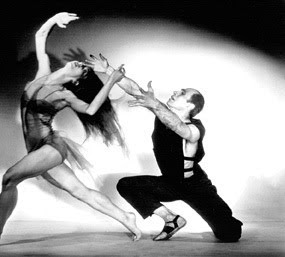
I think the biggest influence and collaboration in Jose Limon's artistic shaping was Doris Humphrey when Jose went to study with her and Charles Weidman, he learned a great deal of what he went off to use in his choreography.
Humphrey's greatest contribution came from her thought of dance as existing in an arc between two deaths: the body lying prone or standing firmly erect--both stable, both lacking in theatrical excitement. Kinetic interest was stirred when the body, venturing from its position of stability, encountered the pull of gravity, defied it, and triumphantly reclaimed its equilibrium. The theory of 'fall and recover,' as it was called, was at once a pure movement idea and a dramatic concept. The threat motivated action that engendered designs in space and time; it also symbolized the eternal conflict between man's longing for security and his desire to risk the dangers of the unknown. In Humphrey choreography, he always dared the dangerous adventure and always emerged victorious. (http://www.aristos.org/whatart/limon.htm)
Not sure what exactly is happening in the world when Jose Limon was choreographing but by researching a few of his pieces I notice what may have inspired him.
The Moors Pavane 1949: captures the drama and passion of Shakespeare's Othello in a timeless portrayal of love, jealousy, and betrayal.
The Traitor 1954: Like the arch-betrayer Judas Iscariot, the protagonist in this dance drama symbolizes all those tormented men who, loving too much, must hate; these men who to our own day must turn against their loyalties, friends and fatherlands, and in some fearful cataclysm of the spirit, betray them to the enemy. Against a music score of dissonant violence, passion and tenderness, the tragedy of Judas is portrayed as if it were taking place in our time.
There is a Time 1956: "To every season, and a time to every purpose under the heaven" -Ecclesiastes Chapter 3. The entire work is, both choreographically and musically, a theme with variations. Limón used as his theme a large circle, which, at the opening of the work, fills the stage and moves majestically as if to evoke the interminable passage of time. This circle is seen repeatedly in many guises, rhythms and dramatic shapes, always making allusion to the text from Ecclesiastes and its evocation of human experience.
A Choreographic Offering 1964: This work was created as a tribute to Limón's mentor, Doris Humphrey. The piece is based on movements from her dances, and contains variations, paraphrases and motifs from 14 Humphrey works.
Chaconne 1971: The Chaconne as a dance form originated in New Spain, now Mexico, as a robust and raucous dance. Bach employed the strict musical form of the Chaconne but enriched it with powerful emotional implications. Limón tried to capture in his dance both the formal austerity and the profound feeling of the music.
Dances for Isadora 1971: Homage to Isadora Duncan with five solo dances to Chopin. "In five solos Mr. Limón evokes both the actual images of Duncan's politically revolutionary dances and the equally real melodrama of her biography." - Anna Kisselgoff, New York Times, October 1972
Dances for Isadora from Jose Limon on Vimeo.
The Traitor 1954: Like the arch-betrayer Judas Iscariot, the protagonist in this dance drama symbolizes all those tormented men who, loving too much, must hate; these men who to our own day must turn against their loyalties, friends and fatherlands, and in some fearful cataclysm of the spirit, betray them to the enemy. Against a music score of dissonant violence, passion and tenderness, the tragedy of Judas is portrayed as if it were taking place in our time. (http://www.limon.org/Dance/Repertory.php) In just these few dances that Limon has created I noticed that he is inspired by many things; he explores dance history researching Isadora Duncan and Doris Humphrey, in the dances he created in honor of them and their movement. Limon gets inspired off of greek mythology and stories and scripture in the Bible. He explores jealousy, love, hate, friendship and loyalty in many of his pieces. He also sets things choreographically and musically to make the piece a dance! He collaborated with many people. Leaving the Humphrey-Weidman company, Limon worked with May O’Donnell to create War Lyrics. O’Donnell and Limon also co-choreographed Curtain Riser, This Story is Legend and Three Inventories on Casey Jones. This was also the year when Limon married Pauline Lawrence, October 3, 1942. The partnership with O’Donnell dissolved the following year and Limon created Chaconne for a program at Humphrey-Weidman. Limon’s final appearance on Broadway was Balanchine’s Rosalinda in which he partnered with Mary Ellen Moylan. 1943, Limon and Humphrey created dances on American and folk themes at the Studio Theatre before Limon was drafted into the Army in April. A year later he was collaborating with composers Frank Loesser and Alex North and choreographed several works for U.S. Army Special Services. He choreographed Concerto Grosso in 1945 and was discharged from the Army that December. Even the Army had an influence on his creating choreography! (http://en.wikipedia.org/wiki/José_Limón)

